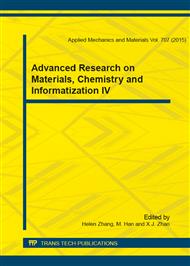[1]
R. V. Rao. Decision Making in Manufacturing Environment Using Graph Theory and Fuzzy Multiple Attribute Decision Making Methods. (Springer-Verlag, London 2013).
DOI: 10.1007/978-1-4471-4375-8_2
Google Scholar
[2]
R. J. Girubha and S. Vinodh. Application of fuzzy VIKOR and environmental impact analysis for material selection of an automotive component. Materials & Design, Vol. 37 (2012), P. 478-486.
DOI: 10.1016/j.matdes.2012.01.022
Google Scholar
[3]
A. Shanian and O. Savadogo. A material selection model based on the concept of multiple attribute decision making. Materials and Design Vol. 27 (2006), pp.329-337.
DOI: 10.1016/j.matdes.2004.10.027
Google Scholar
[4]
A. Shanian and O. Savadogo. TOPSIS multiple-criteria decision support analysis for material selection of metallic bipolar plates for polymer electrolyte fuel cell. J. Power Sources, Vol. 159 (2006), pp.1095-1104.
DOI: 10.1016/j.jpowsour.2005.12.092
Google Scholar
[5]
K. Maniya and M.G. Bhatt. A selection of material using a novel type decisionmaking method: preference selection index method. Materials and Design Vol. 31 (2010), pp.1785-1789.
DOI: 10.1016/j.matdes.2009.11.020
Google Scholar
[6]
R.V. Rao. Decision making methodology for material selection using an improved compromise ranking method. Materials and Design Vol. 29 (2008), p.1949-(1954).
DOI: 10.1016/j.matdes.2008.04.019
Google Scholar
[7]
A. Kasaei, A. Abedian and A.S. Milani. An application of Quality Function Deployment method in engineering materials selection. Materials & Design, Vol. 55 (2014), pp.912-920.
DOI: 10.1016/j.matdes.2013.10.061
Google Scholar
[8]
X. J. Xie. Material selection using TOPSIS combined with grey relation analysis. Applied Mechanics and Materials, Vol. 540 (2014), pp.476-479.
DOI: 10.4028/www.scientific.net/amm.540.476
Google Scholar
[9]
L. W. Yang. Projection method for material selection problem with interval numbers. Advanced Materials Research, Vol. 1022 (2014), pp.14-17.
DOI: 10.4028/www.scientific.net/amr.1022.14
Google Scholar
[10]
E. K. Zavadskas, A. Kaklauskas and V. Sarka. The new method of multi-criteria complex proportional assessment of projects. Technological and Economic Development of Economy, Vol. 1 (1994), pp.131-139.
Google Scholar
[11]
E. K. Zavadskas, A. Kaklauskas, Z. Turskis, and E. J. Tamošaitien. Selection of the effective dwelling house walls by applying attributes values determined at intervals. J Civ Eng Manage, Vol. 14 (2008), p.85–93.
DOI: 10.3846/1392-3730.2008.14.3
Google Scholar
[12]
Viteikiene M, Zavadskas EK Evaluating the sustainability of Vilnius city residential areas. J Civ Eng Manage, Vol. 8 (2007), pp.149-155.
Google Scholar
[13]
A. Kaklauskas, E. K. Zavadskas, S. Raslanas, R. Ginevicius, A. Komka and P. Malinauskas. Selection of low-e tribute in retrofit of public buildings by applying multiple criteria method COPRAS: a Lithuanian case. Energy Build, Vol. 38 (2006).
DOI: 10.1016/j.enbuild.2005.08.005
Google Scholar
[14]
E. K. Zavadskas, A. Kaklauskas, F. Peldschus and Z. Turskis. Multi-attribute assessment of road design solution by using the COPRAS method, Baltic J Road Bridge Eng, Vol. 2 (2007), pp.195-203.
Google Scholar
[15]
S. Datta, G. S. Beriha, B. Patnaik and S. S. Mahapatra. Use of compromise ranking method for supervisor selection: a multi-criteria decision making (MCDM) approach. Int J Vocat Tech Educ, Vol. 1 (2009), pp.7-13.
Google Scholar
[16]
B. H. Men and C. Liang. Attribute recognition model-based variation coefficient weight for evaluating water quality, Journal of Harbin Institute of Technology, Vol. 37 (2005), pp.1373-1375.
Google Scholar
[17]
A. Jahan, M. Bahraminasab and K. L. Edwards. A target-based normalization technique for materials selection. Materials & Design Vol. 35 (2012), pp.647-654.
DOI: 10.1016/j.matdes.2011.09.005
Google Scholar
[18]
K. R. Sarfaraz, M. B. Dehghan, A. Abedian and R. Mahmudi. A simplified fuzzy logic approach for materials selection in mechanical engineering design. Materials & Design, Vol. 30 (2009), pp.687-697.
DOI: 10.1016/j.matdes.2008.05.026
Google Scholar
[19]
P. Chatterjee, V. M. Athawale and S. Chakraborty. Materials selection using complex proportional assessment and evaluation of mixed data methods. Materials & Design, Vol. 32 (2011), pp.851-860.
DOI: 10.1016/j.matdes.2010.07.010
Google Scholar
[20]
M. B. Dehghan, H. Mahmudi, A. Abedian and R. Mahmudi. A novel method for materials selection in mechanical design: Combination of non-linear normalization and a modified digital logic method. Materials & Design, Vol. 28 (2007), pp.8-15.
DOI: 10.1016/j.matdes.2005.06.023
Google Scholar


